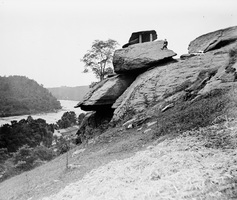 | Back to e-WV
| Back to e-WV
 The West Virginia Encyclopedia
The West Virginia Encyclopedia
 | Back to e-WV
| Back to e-WV
 The West Virginia Encyclopedia
The West Virginia Encyclopedia

Jefferson Rock, a prominent outcropping of the sedimentary stone known as Harpers shale, is on the southern hillside of Harpers Ferry, just above St. Peter’s Church. From it may be seen a prime view of the confluence of the Potomac and Shenandoah rivers in the gap between the Maryland and Virginia heights.
The rock was named for Thomas Jefferson, who wrote in his 1785 book, Notes on the State of Virginia, that the view was ‘‘worth a voyage across the Atlantic.’’ Other people would visit the rock afterward, and compare their impression with that of Jefferson. Some, including John Quincy Adams, made critical comparisons. ‘‘There is not much of the sublime in the scene, and those who first see it after reading Mr. Jefferson’s description are usually disappointed,’’ Adams wrote in 1834.
The uppermost slab of Jefferson Rock originally rested on a natural stone foundation that was reduced to unsafe dimensions by erosion and souvenir seekers. Four short stone piers were placed under the slab between 1855 and 1860 to stabilize and further distinguish the rock, making it seem to some as a ‘‘steam ferryboat’’ immortalized in stone.
Written by Walton Danforth Stowell Jr.
Gilbert, David. A Walker's Guide to Harpers Ferry, West Virginia. Charleston: Pictorial Histories Publishing Company, 1983, Reprint, Harpers Ferry Historical Society, 1995.